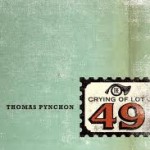Our book choice for December 2009 is The Crying of Lot 49 by Thomas Pynchon. Short, straightforward in narrative, and relatively linear in plot, The Crying of Lot 49 is considered by many to be Pynchon’s most accessible novel, and is therefore the one most commonly read.  The plot is simple. Oedipa Maas, a practical but restless woman married to a disc jockey, finds out that she has been made the executor of the estate of Pierce Invararity, a rich industrialist and the subject of a past fling. Confused but curious, she travels to San Narciso (A mythologized city in California) in order to carry out her duties. But almost at once she discovers that things are not what they seem. Soon she begins to suspect that she has stumbled upon a conspiracy — a vast, perhaps global conspiracy that involves Inverarity, his lawyers, the employees of Yoyodyne and maybe even her husband and analyst. Driven by a will she hardly knew she possessed, and haunted by an impending sense of revelation, Oedipa decides to penetrate to the heart of the enigma. Eventually she merges into an underworld of broken, lonely souls, cynical playwrights and mysterious booksellers; a shadowy “alternate America” where coincidences accumulate suspiciously and the postal system takes on sinister overtones. Is it coincidence or conspiracy — or a cruel joke? And as the mystery deepens, she edges perilously close to a downward spiral of self-doubt and paranoia.
The plot is simple. Oedipa Maas, a practical but restless woman married to a disc jockey, finds out that she has been made the executor of the estate of Pierce Invararity, a rich industrialist and the subject of a past fling. Confused but curious, she travels to San Narciso (A mythologized city in California) in order to carry out her duties. But almost at once she discovers that things are not what they seem. Soon she begins to suspect that she has stumbled upon a conspiracy — a vast, perhaps global conspiracy that involves Inverarity, his lawyers, the employees of Yoyodyne and maybe even her husband and analyst. Driven by a will she hardly knew she possessed, and haunted by an impending sense of revelation, Oedipa decides to penetrate to the heart of the enigma. Eventually she merges into an underworld of broken, lonely souls, cynical playwrights and mysterious booksellers; a shadowy “alternate America” where coincidences accumulate suspiciously and the postal system takes on sinister overtones. Is it coincidence or conspiracy — or a cruel joke? And as the mystery deepens, she edges perilously close to a downward spiral of self-doubt and paranoia.
Discussion Questions
- Is The Crying of Lot 49 a mystery novel?
- What does Oedipa learn about The Tristero through her own observations and what through her own and others’ conjecture? What conclusions does she draw? What do you think The Tristero represents? What are the implications of the acronym, W.A.S.T.E.?
- The novel deals extensively with history and the messages of history. What can the reader gain from understanding the history of the Tristero? Why is it included in the novel?
- What role do letters play in the book?
- Consider the songs of The Paranoids to the songs sung in Yoyodyne or the song of Baby Igor. Why are there so many songs and lines of verse in this novel?
- What does Pierce Inverarity—with all his voices and all his possessions (while alive)— represent?
- Pynchon chooses distinctive names for characters – Dr. Hilarius; Mike Fallopian, Genghis Cohen, Warpe, Wistfull, Kubitschek and McMingus; Clayton Chiclitz; Emory Bortz, etc. Why did he choose these names?
- Major Theme is the conflict between chaos and order. How does the novel treat the idea of chaos in culture and society? Did you feel chaotic whilst reading it?
- WASTE
- Hippie band The Paranoids
- Invararieity’s estate
- Is the book about Oedipa’s endeavours as an attempt to impose order on a chaotic universe? Does she encounter any systems which do bring order?
- San Narciso expressed as a printed circuit envisioned by Oedipa
- Maxwell’s Demon
- Mucho’s job as a DJ, bringing a type of order to random, individual songs by different bands
- The U.S. Postal System, which has a highly ordered, organized monopoly
- What is Maxwell’s Demon and why did Pynchon include it?
- How are the Nefastis Machine and what it represents related to the “two distinct kinds” of entropy and related to Oedipa’s search?
- The entropy posited by the Second Law of Thermodynamics (the inevitable deterioration of any system to a state of disorder and zero energy or meaning) and that of information systems (a tendency to discard excess meanings and approach certainty and predictability)
- How does Oedipa change over the course of the novel? How does her social situation change? Do you relate to her?
- Why did Pynchon included the Inamorati Anonymous?
- After speaking with Driblette’s mother and with the neo-fascist “Winner” Tremaine, the troubled Oedipa thinks, “This is America, you live in it, you let it happen.” What do you think this means?
- Why does Pynchon leave Oedipa’s quest unresolved? What more might she learn at the crying of lot 49? What are we to make of the possibility that this is all a joke?
Individual Ratings
DKB Rating 





